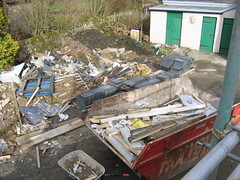Why organising a large music collection is a little like gardening
October 02, 2010 in digital music by Dan Gravell
Large music collections are increasingly common. Large music collections of over one thousand albums and tens of thousands of MP3s are easy to build now that acquiring music is so simple.
Yet just as a gardener would not expect to throw a few shrubs, trees and flowers into a garden, walk away, and expect the garden to look and remain beautiful, so must your music collection require cultivation, pruning and husbandry.

It doesn't matter whether your music collection is in the tens of albums or tens of thousands; you want your collection well organised. And so you, as a brave digital music collector, will strive for a clean, catalogued library. Along the way you will discover some of the inevitable truths of digital music collections: that organising music collections is error prone, and consistency is key.
Truth #1: You will make mistakes
Building a music library is an organic process. You add albums as they are released and your collection steadily grows. It is inevitable you will learn more about how to organise digital music as time goes by.
I think an example of this that many digital music collectors encounter is the realisation, after a while, that the MP3 file format is a bit of a dead-end. Typically the sound quality is lower than CD, and because they are 'lossy' you can never retrieve that quality, short of re-ripping from the original music source. Down the years, what tends to happen is that you transition from one file format to another as you discover different file formats have different advantages. I started with MP3 because that's what my first CD ripper ripped to by default. Later on I had a dalliance with Ogg Vorbis as I went through an open source phase, and finally after following other people's advice I began ripping to FLAC. What I should do now is go back and re-rip all those MP3s and Oggs to FLAC, but frankly I don't have the time.
We also make mistakes with the way we organise music. For instance, for cataloguing purposes I originally didn't understand the significance of the 'album artist' tag originally; now it's a required tag for me. Similarly, I let my genre tree get out of control and I have neither the time nor the patience to fix it.
Truth #2: Consistency is key
Here's the thing: I wouldn't necessarily mind having some of the mistakes or mistaggings in my library if the mistakes were consistent through the library. Sadly I have some albums with specific genres and some with general ones; some compilations have "Disk 2" appended to the album name while others have "Disc II"; and until I ran bliss to organise my album art I had some embedded, some missing, some too large and so on.
If there's a consistent mistake it's easier to rectify. Unfortunately, because music is often categorised by unreliable sources these mistakes come in many forms. It's annoying to browse through your music and see all these ugly elements: disk number artifacts, incorrect genres and more.
Why organising large music collections is like gardening
It's not enough to organise your music and eliminate inconsistencies in one mega all-night organising session. Likely you'll want to add more music in time. Like weeds in a garden the new music you introduce will sprout their own inconsistencies between the way you have organised your existing music and how the new music has been organised. For instance, the new music may be assigned a genre that you find too specific for your ideal genre tree. This might be down to the source of the music, or the auto-tagging of a CD rip, but these inconsistencies are best dealt with early on. Instead of weed killer, you can use music tagger software.
The trouble with taggers are they don't scale so well for large collections. They are great for making changes to music files but they don't help encode the rules of organisation to ensure your music library remains consistent. That's where rule based music library management comes in. Rather than organise at the file or track level, organise at the library level by specifying rules your music must comply with. Ideally, the rules should be enforceable automatically, so you have more time for listening and less time required for organising.

May your music collection be free of weeds!

